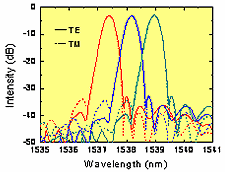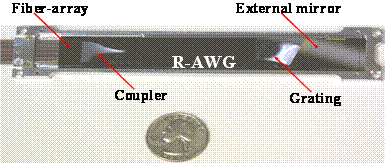Waveguide Optics in a Silicon IC Foundry
A. Bernussi, L. G. de Peralta, J. M. Berg, R. Gale, and H. Temkin
Arrayed waveguide grating (AWG) multiplexers are key components in optical networks based on dense wavelength division multiplexing (DWDM). Silica-on-silicon technology used to fabricate AWGs offers low propagation losses, excellent mechanical stability, and compatibility with single mode fibers. We have realized that this device, and other integrated optics devices, can be constructed in silicon IC foundries, at a considerable saving in cost and improved quality.
Photolithography is done in foundries with projection steppers designed to illuminate an area smaller than 2 x 2 cm 2 at a time. The grating of a conventional AWG is too large for that. We have folded the grating with a reflecting surface resulting in a much smaller device.

Low birefringence waveguides fabricated using a glass cladding layer heavily doped with boron. Solid line - TE, dashed line – TM polarizations.
A grating with 330 waveguides readily fits into the area as small as 1.5 x 1. 8 cm 2. With this design we have been able to fabricate 40 channels, 100 GHz separation, AWGs with excellent performance. We were also able to modify standard dielectrics used by foundries, by high boron incorporation, to lower the stress and produce waveguides with negligibly low birefringence.
The folded grating of our device makes it possible for us to approach one of the most difficult problems of AWGs, their temperature sensitivity. This arises from the temperature induced changes in the index of refraction of the glass forming the waveguide. The physical manifestation of the index change is the temperature-induced rotation of the optical field at the grating. Our solution is to replace the reflecting surface folding the grating with an external mirror. The mirror is constructed from materials with different thermal expansion coefficients and its reflecting surface rotates with temperature at the same rate but in the opposite direction, compensating for temperature changes. First prototypes of devices based on this principle indeed show athermal operation. This device does not require temperature control and is very simple to operate. A patent for this idea was filed for us by Texas Tech University in February 2004.
Research Support: State of Texas TDT, Texas Instruments, Multipass Inc.
 A prototype of an athermal AWG based on an external mirror.
A prototype of an athermal AWG based on an external mirror.Nano Tech Center
-
Address
Texas Tech University | Whitacre College of Engineering -
Phone
806.742.3533 -
Email
webmaster.coe@ttu.edu
